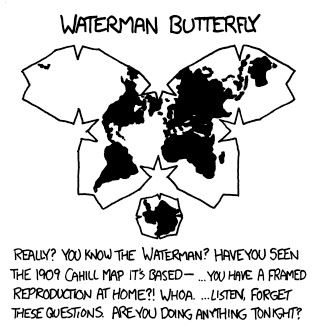

Nice. That shows a bit clearer how geography, not just distance, affects latency.


Nice. That shows a bit clearer how geography, not just distance, affects latency.


Thanks!
Is that Azimuthal projection centred on London though? It looks like it’s centred in Africa but maybe that’s just because the top-left is cropped off because it’s all ocean?


Can you show different projections? Like one that keeps distances from you the same (countries will look very stretched at the far end but radial distances from you are preserved). It looks like the latency doesn’t quite follow physical distance from you, but it’s hard to tell because of the projection.
(Interesting map though, thank you!)

and?


I think it might not be possible.
Imagine the population is a uniform circle centred around that intersection point so the quadrants have equal population - but make the circle small enough it doesn’t reach Belfast.
Now add one person in Belfast. How do we move the lines slightly so it’s still right?
If you move NNW along the line, Belfast quadrant can match Oxford and Cambridge, but Edinburgh is too small. If you move WSW, Edinburgh, Cambridge and Belfast quadrants match but Oxford is too small.
If you move the intersection point directly toward Belfast, does that work? I think Cambridge quadrant grows faster than either Edinburgh or Oxford.
You can rotate it first. Not a tiny amount but all the way round to make one line go through Belfast’s new resident. Then move the intersection slightly.
So that means, for a tiny change (continuous variation) in the population distribution, the supposed intersection and/or angle are discontinuous (sudden big change). That discontinuity ruins my approaches to finding a proof, and I think means there might not be one. It might not always be possible to get perpendicular equal quadrants like that.
That’s as far as I got, anyway!


Edit: Sorry, meant to reply to a comment


You can bisect the population with a line at any angle or passing through any given point. Given any one bisecting line, you can find another line that splits the map into four equal quadrants, but the lines wouldn’t necessarily be perpendicular.
I’ll see if I can come up with a proof for a perpendicular quad-section, and reply to the comment above.
Edit: I can’t. Not simple enough for me to find at the moment!


Taking a second look at that, though - is that really a continuous projection? Or is that storing different parts as different chunks (and maybe projected differently) put together into the one image?


Huh, neat!


It’s still a Mercator projection if you take any part of a map projected thusly. (And there’s the “modified universal transverse Mercator” that, I think, is that with some grid offset.)
But, see my edit, this image isn’t doing that. It’s stretching a “picture of half a face superimposed on a larger half globe,” not the half-face as if the head were the globe.


This has got to be wrong. A human head, projected like a world map, would show both eyes and both ears, except in the case of showing only one half (like when you only show/photograph the Americas).
This appears to take a picture of the side of the head (i.e. that particular projection, showing less than half of the full globe), then distort it as if it were already a different projection.
Edit: worse than that. The globe onto which the half-head-image is superimposed in the top right is larger than the head. Like if you took a photo of the Americas half of the world from space, pasted that onto a larger beach ball, then stretched the result to demonstrate the projections.
That sounds particularly suspect, coming with no answer as to what it does mean.